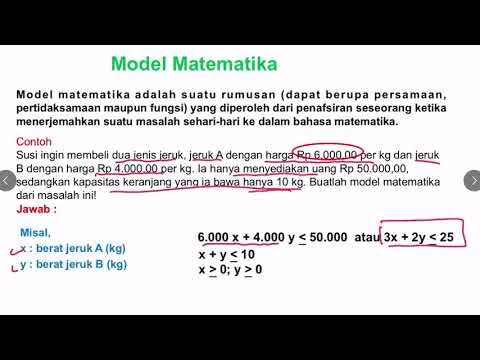Integer Linear Programming - Binary (0-1) Variables 1, Fixed Cost
Summary
TLDRThis tutorial explores the formulation of linear integer programming models involving binary (0-1) variables. It demonstrates the application of binary variables in decision-making situations, such as selecting projects or machines for production. The video covers the steps to formulate objective functions, constraints, and decision variables, with examples of maximizing returns from projects and minimizing costs in a production scenario. By solving these models, the tutorial showcases how to optimize decisions based on available resources and fixed costs. It concludes by hinting at the next video, which will address relational constraints using binary variables.
Takeaways
- 😀 Binary variables are used to model yes/no decisions, indicating whether a selection is made or not (e.g., selecting projects).
- 😀 The decision variable for a project (Xi) is defined as 1 if the project is selected and 0 if it is not.
- 😀 In the project selection example, the goal is to maximize net return, expressed as 217X1 + 125X2 + 88X3 + 109X4.
- 😀 Constraints are applied for monthly outlays, ensuring that selected projects do not exceed available funds for each month (e.g., 58X1 + 44X2 + 26X3 + 23X4 ≤ 120).
- 😀 A software solution (e.g., LINDO or Excel Solver) can be used to solve the linear integer programming model and determine the optimal project selection.
- 😀 The fixed cost problem involves deciding whether to use machines for production, with additional decision variables (Yi) to account for machine usage.
- 😀 For machine usage, Yi = 1 means the machine is used, and Yi = 0 means the machine is not used.
- 😀 The objective in the fixed cost problem is to minimize total costs, which includes both variable costs and fixed costs based on machine usage.
- 😀 Constraints for the fixed cost problem ensure the total production meets the order requirement (X1 + X2 + X3 = 1000) and the production does not exceed machine capacities (e.g., X1 ≤ 400Y1).
- 😀 The solution to the fixed cost problem is to use machines 2 and 3 only, producing 550 units on machine 2 and 450 on machine 3, while machine 1 is not used.
- 😀 In the next video, relational constraints using binary variables will be covered, including multiple choice, mutually exclusive, co-requisite, and conditional constraints.
Q & A
What are binary variables used for in integer programming?
-Binary variables are used to represent yes/no decisions in integer programming, such as whether a selection is made or not. They take the value of 1 if selected and 0 if not selected.
How are binary decision variables defined in the project selection example?
-In the project selection example, binary decision variables are defined as X1, X2, X3, and X4. These represent whether projects 1, 2, 3, and 4 are selected, with 1 indicating selection and 0 indicating non-selection.
What is the objective of the project selection problem?
-The objective of the project selection problem is to maximize the net return, represented by the objective function 217X1 + 125X2 + 88X3 + 109X4.
What constraints are placed on the project selection problem?
-The constraints in the project selection problem ensure that the total cost of selected projects does not exceed the available funds each month (January, February, and March). The constraints are written as 58X1 + 44X2 + 26X3 + 23X4 ≤ 120, and similarly for February and March.
What is the optimal solution for the project selection problem?
-The optimal solution for the project selection problem is selecting projects 1, 3, and 4, with X1 = 1, X2 = 0, X3 = 1, and X4 = 1, resulting in a total net return of 414.
What is the main objective in the fixed cost problem example?
-The main objective in the fixed cost problem is to minimize total costs, which includes both variable production costs and fixed costs associated with machine usage.
How are the decision variables defined in the fixed cost problem?
-In the fixed cost problem, two sets of decision variables are used: X1, X2, and X3, representing the number of units produced on machines 1, 2, and 3, respectively, and Y1, Y2, and Y3, representing whether machines 1, 2, and 3 are used (1 if used, 0 if not).
What does the constraint X1 + X2 + X3 = 1000 represent?
-The constraint X1 + X2 + X3 = 1000 ensures that the total number of units produced by all machines is exactly 1000, fulfilling the order placed by the customer.
How are the machine capacity constraints modified in the fixed cost problem?
-The machine capacity constraints are modified by multiplying the capacity of each machine by the corresponding binary variable. For example, X1 ≤ 400Y1 means that machine 1 can produce up to 400 units only if it is used (Y1 = 1).
What is the optimal solution for the fixed cost problem?
-The optimal solution for the fixed cost problem is to produce 550 units on machine 2 and 450 units on machine 3, with machine 1 not being used. The corresponding binary variables are Y1 = 0, Y2 = 1, and Y3 = 1.
Outlines

This section is available to paid users only. Please upgrade to access this part.
Upgrade NowMindmap

This section is available to paid users only. Please upgrade to access this part.
Upgrade NowKeywords

This section is available to paid users only. Please upgrade to access this part.
Upgrade NowHighlights

This section is available to paid users only. Please upgrade to access this part.
Upgrade NowTranscripts

This section is available to paid users only. Please upgrade to access this part.
Upgrade NowBrowse More Related Video

Recherche opérationnelle : Formulation d'un programme linéaire

Pergeseran Bit dan Operasi Logika pada Pemrograman Operator Bahasa C

MENENTUKAN MODEL MATEMATIKA DARI SOAL CERITA SPtLDV

PROGRAM LINIER - METODE GRAFIK - RISET OPERASI

#1 LPP formulation problem with solution | Formulation of linear programming problems | kauserwise®

Hidden Dynamics T1 Video 1
5.0 / 5 (0 votes)